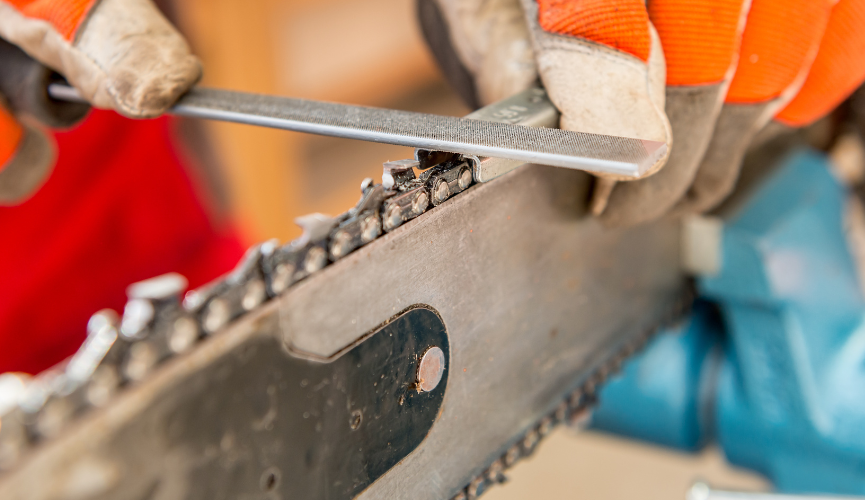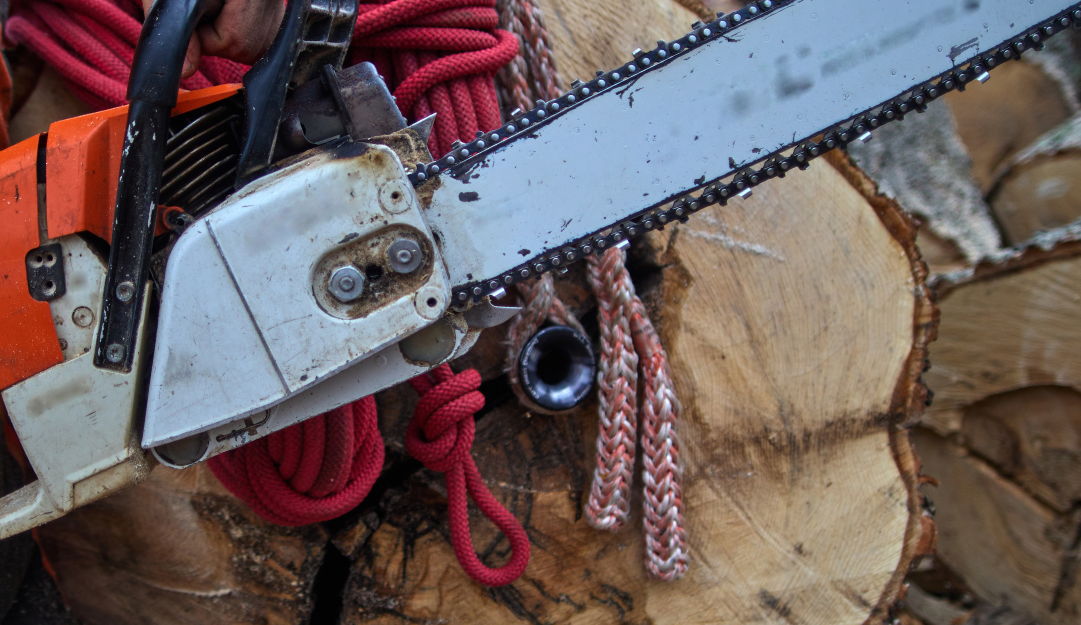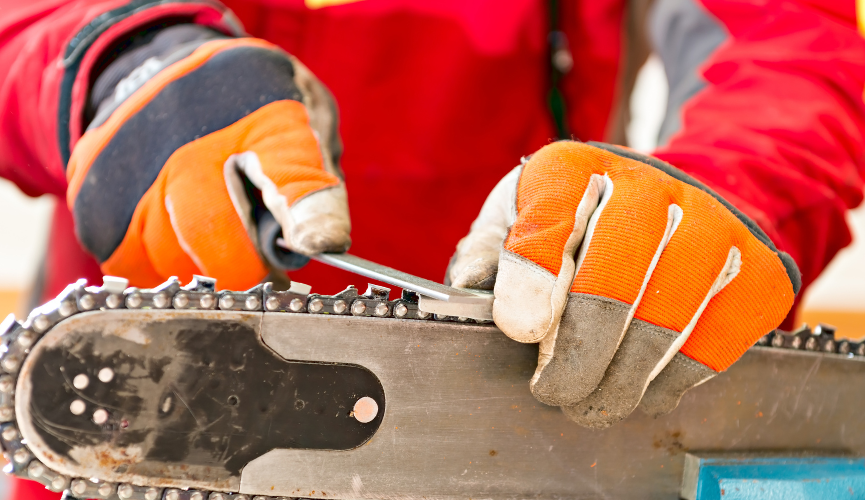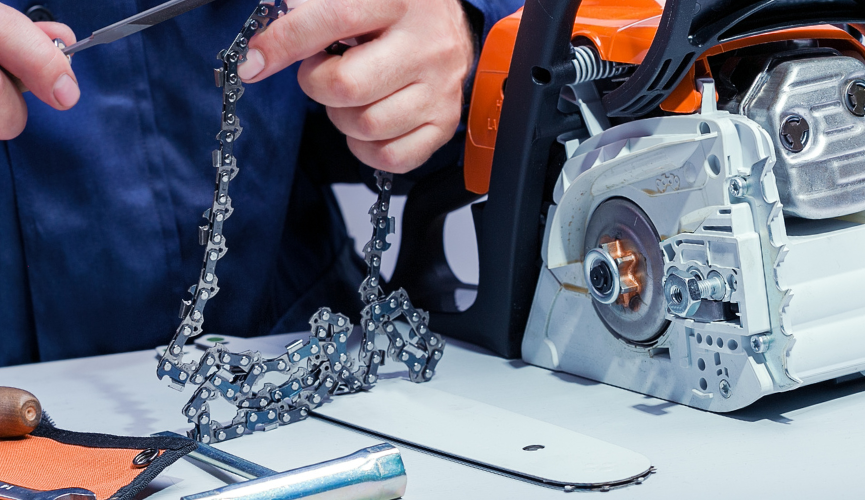How To Sharpen A Chainsaw Chain

Key Takeaways
- Regularly sharpening your chainsaw can save you time and money in the long run.
- Understanding the sharpening process, safety precautions, and tools and materials is essential before starting.
- Proper maintenance and troubleshooting can help keep your chainsaw in good working order.
- Refer to owner's manual for your specific chainsaw
If you're a homeowner or a professional logger, you know that a dull chainsaw can be frustrating and dangerous. A dull chainsaw can cause the saw to bind, produce smoke, and make it difficult to cut through wood.
But before you go out an buy a new chain, let's talk about sharpening chain your saw's chain.
Sharpening your chainsaw regularly can save you time and money in the long run, and it's a straightforward process that you can do yourself. In this article, we'll go over the basics of how to sharpen a chainsaw, including understanding chainsaw sharpening, safety precautions, tools and materials, sharpening techniques, adjusting the chainsaw chain, maintenance, and troubleshooting.

Before we dive into the specifics of how to sharpen a chainsaw, it's important to understand why chainsaws become dull in the first place. Every time you use your chainsaw, the teeth on the chain scrape against the wood, which causes the edges to become dull.
Over time, the chain will become too dull to cut through wood effectively. Sharpening your chainsaw involves filing down the teeth to restore their sharpness. While it may seem daunting at first, with the right tools and techniques, you can easily sharpen your chainsaw and get back to work in no time.
What To Know Before Sharpening A Chainsaw
It's important to understand how the chainsaw teeth work before you start sharpening the chain. The small tooth in front is what makes initial contact with the wood.
The raker tooth contacts the wood, and then the larger tooth behind it comes and chisels a slot behind the contact point. The rear teeth alternate between left and right cuts along the length of the chain.
Multiply that by the hundreds of teeth on the chainsaw chain, and that's how chainsaws cut through wood. The best way to sharpen a chainsaw is with a round file.
When To Sharpen Your Chain
Other than the warning signs we listed above, there are some better times to sharpen your chain before it becomes dire. Most professionals are sharpening their chain through the workday.
But here's a tip: every time you put gas in the chainsaw is when you should do chainsaw sharpening. That way you never forget to to do it.

Safety Precautions
When sharpening a chainsaw, it is important to wear the appropriate protective gear to avoid any potential injuries. Nothing complicated - shouldn't need chainsaw chaps here. The following protective gear is recommended:
- Safety glasses: Wear safety glasses to protect your eyes from flying debris and wood chips.
- Gloves: Wear gloves to protect your hands from the sharp chain. If you are careful, you really don't need these. You can push the chain forward with the round file.
Preparing the Workspace
Before starting to sharpen your chainsaw, make sure that your workspace is safe and free of any potential hazards. Here are some important things to consider:
- Clear the area: Ensure that there are no objects or debris in the workspace that could cause you to trip or fall.
- Secure the chainsaw: Make sure that the chainsaw is securely clamped or anchored in place before you begin sharpening. Either with a vice or with your legs.
- Chain brake: Make sure that the chain brake is engaged to prevent the chain from moving while you are sharpening.
Types of Files
There are several types of files that you can use to sharpen your chainsaw. The most common types are flat files and round files. Round files are used to sharpen the cutting teeth, while flat files are used to sharpen the depth gauges.
Using A Vice
It's not required, but if. you have a vice, we recommend you lightly clamp your chainsaw in the vice before you sharpen it. This just provides an extra layer of stability in the chainsaw, and consistency with your cut.
If you are out in the woods or don't have a vice, then straddle the back of the chainsaw with your legs and file the chainsaw that way.
Preparing the Chainsaw
Before you begin sharpening your chainsaw, it's important to make sure that the saw is properly cleaned and lubricated. This will help to ensure that the file moves smoothly over the cutters and that the saw is able to operate at its best.
Clean the saw thoroughly, removing any dirt, sawdust, or debris from the chain and bar. You don't need to adjust the chain tension or lubricate the chain with bar and chain oil before you sharpen it. We will be taking the chainsaw bar off to inspect it during the process.

How To Sharpen Your Chainsaw
Let's cut to the chase: here's how to sharpen your chain (if you want to know the why and when, the scroll below).
Step 1: How To Sharpen a chainsaw chain with a round file - the technique
A good chainsaw will have an indicator on the chainsaw teeth of which way to hold the file. Hold the file against the larger rear tooth in the angle of that indicator.
File the chainsaw on the push stroke only. Do not file with a pull stroke. Push against the rear tooth with in a straight line at the proper angle. Make the tooth that you start at with a permanent marker so you'll know where you began.
Each chainsaw will require a different size hand file. Refer to the owner's manual for the file's diameter. Also, the easiest way to sharpen the chain is to do the right rear teeth first, then go back and do the left rear teeth. This way, you don't need to change your hand grip each time.
Step 2: Getting the teeth length right
This is not an exact science but you want the chainsaw teeth to be at about the same length. The teeth need to be the same amount of metal because of how they cut through the wood.
Remember we said that the teeth cut in alternating fashion: left right, left right. If one tooth is shorter than the proceeding other tooth, the shorter tooth won't actually cut the wood because the longer tooth cut deeper than it would able to cut.
Step 3: Getting the raker depth right
The more you take off the rear teeth, the more you'll need to adjust the depth of the raker. If you lay a flat file on the two, then you should see some space between the front raker and the rear tooth.
The depth should be about 0.6 mm. Again, this isn't rocket science and there are ways to measure the depth with a depth gauge but eyeballing can work.
We recommend you get a professional to show you how to sharpen a chainsaw chain the first time. Be careful because too much depth can increase kickback.
If the rakers are higher than the rear teeth, the rear teeth won't engage with the wood and you won't be cutting anything.
Step 4: Check the bar
If you've done all these steps and the chainsaw isn't cutting right, you need to rotate the bar. Periodically rotate the bar otherwise you are going to wear out one side.
Check for burrs along the length of the bar. Overtime, using a hot chainsaw will create a small bur along the length of the bar. To remove this, simply run a flat file along the bar using push strokes. Do this on all four edges of the bar groove until there is no burr left.
Finally, make sure the bar is straight. If it's twisted or crooked, you'll probably need to get a new bar.
Remember, use a round file for the rear teeth and a flat file for the raker. It would be impossible to cover all the different sizes and depths required for all the different chainsaws so be sure to refer to your user manual.
Why You Need To Sharpen Your Chain
If you own a chainsaw, it's important to know how to sharpen it. A dull chainsaw can be dangerous and less efficient, making your work more difficult and time-consuming.
A sharp chain is crucial for efficient and safe cutting. It allows the chainsaw to cut more efficiently, making your work faster and easier
A dull chain can cause kickback, which is when the chainsaw suddenly jumps back towards the operator. This can cause serious injury or even death. Plus, a dull chain will simply not cut well. Talk about annoying.
Signs of a Dull Chainsaw
There are a few signs that your chainsaw may be dull and in need of sharpening:
- the sawdust produced by the chainsaw is finer than usual
- the chainsaw is taking longer to cut through wood
- the chainsaw is producing smoke or burning the wood instead of cutting it cleanly
To sharpen your chainsaw, you'll need to focus on the cutting teeth of the chainsaw blade. These are the small, sharp teeth that actually cut through the wood.
There are a few different methods for sharpening a chainsaw blade, including using a file or a chainsaw sharpening tool. Whichever method you choose, make sure to follow the owner's manual and take your time to ensure the chainsaw is properly sharpened.

What Else You Need To Know About Sharpening Your Chain
Filing the Cutters
Filing the cutters is the most important step in sharpening your chainsaw. The angle, pressure, and stroke of your file all play a crucial role in determining the quality of the cutters.
To file the cutters, follow these steps:
- Determine the correct file size for your chainsaw.
- Use a file guide to ensure that you are filing at the correct angle.
- Apply consistent pressure to the file as you stroke it across the cutter.
- File each cutter the same number of times to ensure consistency.
Setting the Depth Gauge
The depth gauges on your chainsaw are responsible for controlling the amount of wood that is removed with each cut. If the depth gauges are set too high, the saw will be difficult to operate and may cause kickback. If they are set too low, the saw will not cut efficiently.
To set the depth gauges, follow these steps:
- Use a depth gauge tool to measure the height of the depth gauges.
- Use a flat file to file down any depth gauges that are too high.
- Check the height of the depth gauges after each filing to ensure that they are consistent.
By following these sharpening techniques, you can ensure that your chainsaw is performing at its best. Remember to maintain consistency throughout the sharpening process and to take your time to ensure that each step is done correctly.
Checking for Evenness
- Check the chain for evenness by examining the shortest cutter. The shortest cutter should be no more than 0.025 inches shorter than the rest of the cutters.
- Use a flat file to file down the rakers to the correct height. The rakers should be approximately 0.020 inches lower than the top of the cutters.
- Use a round file to sharpen the cutters. File each cutter at the same angle and depth to maintain evenness.
Remember to always wear protective gear when working with a chainsaw chain, and follow the manufacturer's instructions for your specific chainsaw model. By properly adjusting your chainsaw chain, you can ensure safe and effective cutting every time.
Maintenance and Troubleshooting
To keep your chainsaw in optimal condition, it's important to perform regular maintenance.
This includes checking the air filter, cleaning the chain, and inspecting the spark plug.
To check the air filter, remove the cover and filter. Clean the filter with compressed air or replace it if it's damaged or dirty.
Cleaning the chain involves removing it from the chainsaw and soaking it in a cleaning solution. Use a brush to scrub off any dirt and debris before rinsing it off and drying it thoroughly.
Inspect the spark plug for any signs of wear or damage. If necessary, replace it with a new one.
Common Sharpening Mistakes
When sharpening your chainsaw, it's important to avoid common mistakes that can damage the engine or reduce cutting performance.
One mistake to avoid is using the wrong size file. Make sure to use a file that matches the size of your chain's teeth. For most chains, a 4 millimeter or 5/32-inch file is appropriate.
Another mistake is not filing at the correct angle. Make sure to follow the manufacturer's instructions for the correct angle.
Finally, avoid over-filing the teeth. Over-filing can cause the chain to become too thin and reduce its cutting performance.
By performing regular maintenance and avoiding common sharpening mistakes, you can keep your chainsaw running smoothly and cutting efficiently.
Final Say On Sharpening Your Chainsaw Chain
Knowing how to sharpen your chainsaw chain will save you tons of money over the years... and tons of headache. You can do it in your garage or out in the field whenever you need it rather than going to a professional or buying a new chain.

Carl Anderson
Carl Anderson is an avid outdoorsman with a keen interest in writing about and reviewing tools. He has over 20 years of writing experience and the only time he isn't feverishly typing away at his computer is when he's outside in nature working on his projects. You can learn more about him here.
Join our community!
Join to receive guides, insights, and the latest gardening deals!
